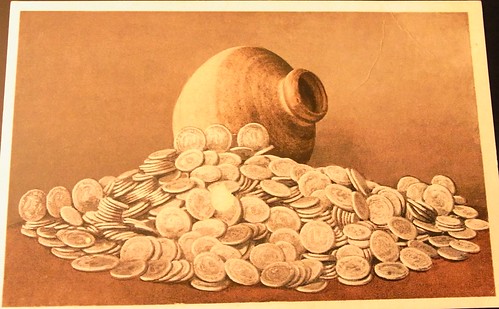
PREV ARTICLE
NEXT ARTICLE
FULL ISSUE
PREV FULL ISSUE
MORE ON THE WASHINGTON'S HEADQUARTERS COIN HOARD

Regarding Tom Kays' old postcard of an oja and Spanish Colonial coins, Phil Flemming of Scottsdale, AZ writes: According to information from the State Museum of New York at Newburgh, Washington's Headquarters, a hoard of about 650 Spanish Colonial coins was found on nearby private land by a local landowner named Silas Corwin on Nov. 12, 1869. Disposition of the hoard is unknown but about 32 coins from it (accession # 1971.347) came into the possession of the Museum at Newburgh, where they can still be seen photographically and sometimes on current exhibit. A quick look-through by obliging museum personnel notes Mexico City 8 reales (columnarios) from 1733 to 1771. Contact ronna.dixson@parks.ny.gov for further information. It's an interesting Revolutionary War emergency hoard that is apparently unpublished and unnoted in Kleeberg's Numismatic Finds of the Americas (2009).
I didn't find this hoard listed in the Colonial Hoards chapter (or index) of Dave Bowers' American Coin Treasures and Hoards (1997), either.
-Editor
Kay Olson Freeman writes: The post card caption says "The Jug" which was found 1869. "Jug" is the operative word. The Jug is all that was left - the coins were put in the picture and are not the originals. The coins were dispersed by the time the post card was made. First, I was very happy to learn online about the history of the Detroit Publishing Co, which used that name 1904/1905 until 1924 (possibly even until 1932). The State Museum, Newburgh, NY, opened its Colonial Revival style building May 27, 1910. It contained many Revolutionary War artifacts. Views of the Museum's interiors are shown on other Detroit Publishing Co. postcards which have the same reverse/address side as the Jug/ Spanish Dollars card. This State Museum should not be confused with the nearby Hasbrouck House which was Washington's headquarters in Newburgh. The treasure postcard was probably made to be sold in the Museum thus the card would date between 1910 and 1924. It required a 1-cent postage stamp. Surprisingly, there is not much reporting of the treasure discovery in 1869 newspapers. The NEWBURGH JOURNAL, November 15, 1869, had the story "Discovery of Hidden Treasure." [I have shortened but added biographical info to 1869 article] In New Windsor, NY [south of Newburgh], owners of a brick yard were building a dock on the Hudson River in order to transport their bricks by ship. The clay soil gave away and 2-1/2 feet underground they found the foot-length earthen water jar filled with 650 Spanish silver dollars dated between 1612 and 1773, There was a slight film of oxide on the coins which was cleaned off. The owner of the brickyard was Francis F. Corwin; but his father, "Deacon" Silas Corwin (b.1789- d.1886), precipitated the accidental discovery. Francis Corwin (b. 1822) had bought the property from Thomas Ellison, Esq, whose grandfather, William Ellison owned the property during the Revolutionary War. There are many Ellisons important in history of New Windsor and they have same first names. It was not thought that William Ellison buried the treasure as he lived beyond the War and presumably would have retrieved it. The treasure was found near the spot where there had been an Army storehouse during the Revolution. At that time, New Windsor was more important than Newburgh as a supply depot. General Knox and Lafayette used the Ellison House for their HQ. George Washington did not. The NEW YORK SUN, newspaper, May 14, 1877, wrote that Samuel Pink "found the stone pot of coin in the brick yard clay-bank of Francis F. Corwin, New Windsor, and which he [Pink] sold to historians and antiquarians for fabulous prices amassing in this one fortunate discovery $41,000." The Yonkers HERALD STATESMAN, April 9, 1956, describes the 18-inches high, light gray clay pot now in the Newburgh Museum [formerly the State Museum]. Says several pieces-of-eight are with the pot at the Museum, but "the rest were given away by the original finder or his heirs." Article describes discovery by Silas Corwin of Spanish pieces- of- eight which were "black with tarnish" at discovery Article author asked Charles Hollander, NY coin dealer, about worth - perhaps $7000 or $3,00 to $12.00 each. BROOKLYN DAILY EAGLE, June 2, 1880, names a man of Riverhead, Long Island, NY, who "has a Spanish dollar dated 1758. It is one of 600 pieces found in the diggings of a brick yard at Newburgh by Silas Corwin."
Thanks for the great information! Neat hoard.
-Editor
To read the earlier E-Sylum article, see:
POSTCARDS AND NUMISMATICS
(www.coinbooks.org/esylum_v16n51a25.html)
The Numismatic Bibliomania Society is a non-profit organization promoting numismatic literature. See our web site at coinbooks.org. To submit items for publication in The E-Sylum, write to the Editor at this address: whomren@gmail.com To subscribe go to: https://my.binhost.com/lists/listinfo/esylum All Rights Reserved. NBS Home Page Contact the NBS webmaster 
|